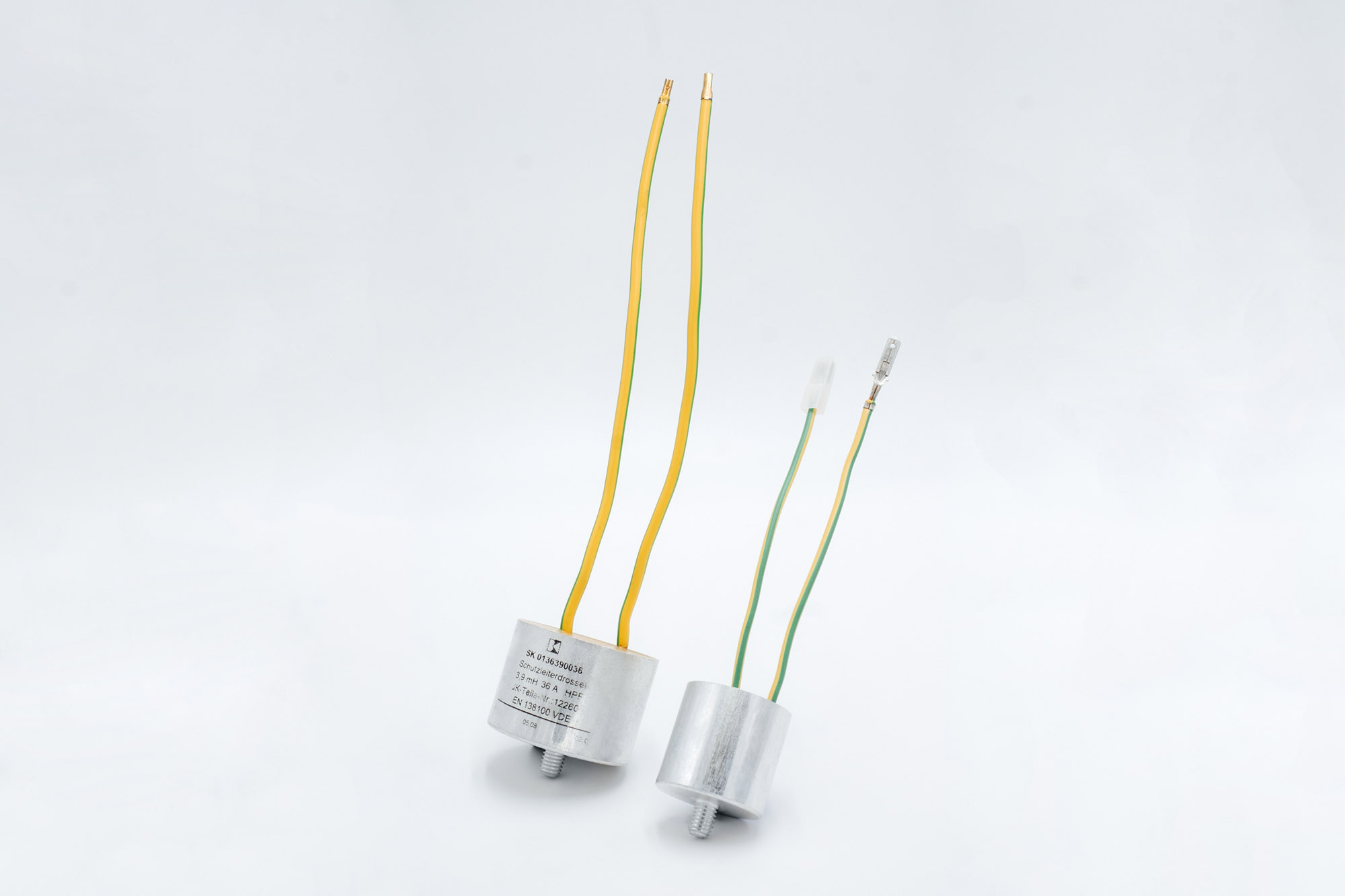Protective earth choke: use, benefits and legal regulations
The protective earth choke is an essential component for ensuring electromagnetic compatibility (EMC) and plays a key role in industrial electrical engineering in particular. Its purpose is to attenuate high-frequency interference that flows via the protective earth conductor (PE), thereby ensuring the functionality, reliability and electrical safety of devices and systems.

The use of protective earth chokes is subject to numerous legal requirements and standards that regulate the safety and interference immunity of electrical systems. Protective earth chokes are used to suppress common-mode interference caused by asymmetrical currents that are fed back via the protective earth conductor.
These interferences occur in particular in systems that operate at high switching frequencies, such as frequency converters, switching power supplies or inverters. The high impedance of the protective earth choke for high-frequency signals effectively interrupts the interference current path without impairing the low-frequency protective functions of the PE conductor.
There are many areas of application for protective earth chokes, but they are primarily used in devices and industrial applications where high electromagnetic compatibility requirements must be met. In frequency converters and drive systems, they help to minimize interference with other electrical devices and play a key role in complying with statutory interference limits. Their use is equally relevant in renewable energy systems, particularly in inverters for photovoltaic systems and wind power systems, where they prevent the spread of conducted interference to other network segments. A key benefit of protective earth chokes is that they improve the electromagnetic compatibility of installations and systems. According to the European EMC Directive 2014/30/EU [1], electrical devices and systems must be designed in such a way that they cause little electromagnetic interference and are themselves insensitive to such interference. Protective earth chokes support compliance with these requirements by increasing immunity to interference and at the same time ensuring that no impermissible interference is transmitted to the power grid or neighboring devices.
In addition, protective earth chokes reduce unwanted high-frequency residual currents, which can cause problems in industrial environments in particular, as they impair the tripping of residual current circuit breakers (RCDs) or trigger their unwanted activation. Protective earth chokes also help to increase the reliability of installations by protecting the PE conductor from potential thermal stress caused by high-frequency interference currents.
Due to their integration into the protective conductor structure, the use of protective earth chokes is subject to strict regulatory requirements, which are defined by legal guidelines and standards. According to DIN VDE 0100-540 [2], protective earth chokes must be designed in such a way that they dissipate low-frequency residual currents unhindered, while high-frequency interference is effectively blocked. Especially for powerful installations and systems this requires careful dimensioning of the chokes in order to meet the requirements. In accordance with DIN EN 60938-1 [3], minimum cross-sections for the cable cross-section of the protective earth choke are defined for different rated current ranges, whereby the protective earth choke itself must be dimensioned for the maximum residual current that can flow through the protective earth conductor. Furthermore, this standard describes both the permissible voltage that may occur at the choke and the resulting maximum permissible impedance. This results in an antiproportional relationship between the maximum rated current and the required inductance. The windings and the materials used in the protective earth choke must remain thermally and electrically stable, even in the event of brief high currents that may occur in the event of a fault.
Although protective earth chokes are indispensable in many applications, they also pose technical challenges. One of these is the thermal load that can occur with high fault currents. This can affectthe long-term stability and reliability of the component. In addition, it is essential that protective earth chokes are designed in such a way that they do not cause any impermissible voltage drops or delays in the protective current path so as not to impair the functionality of protective systems.
In practical applications, the protective earth choke is an important component for ensuring electromagnetic compatibility within industrial and energy contexts, and its use contributes significantly to compliance with legal requirements and maintaining the reliability of electrical systems. Nevertheless, their implementation requires a meticulous planning phase and careful adaptation to the specific requirements of the application. In view of the ongoing development of more powerful systems and the increasing importance of renewable energies, the targeted design of protective earth chokes will play an important role in the coming years.
Sources
- [1] EMV-Richtlinie 2014/30/EU: Elektromagnetische Verträglichkeit von Betriebsmitteln.
- [2] DIN VDE 0100-540: Errichten von Niederspannungsanlagen – Schutzmaßnahmen (2017).
- [3] DIN EN IEC 60938-1 VDE 0565-2:2022-12: Drosseln zur Unterdrückung elektromagnetischer Störungen (2022).
- [4] DIN EN 60204-1: Sicherheit von Maschinen – Elektrische Ausrüstung von Maschinen (2020).
- [5] Paul, C.R. (2018): Introduction to Electromagnetic Compatibility. Wiley.
- [6] Fischer, K., et al. (2023): Advanced Electromagnetic Compatibility Filtering in Industrial Systems. IEEE Transactions on Industrial Electronics.
- [7] Grasso, F., et al. (2021): Challenges in Electromagnetic Compatibility for Renewable Energy Systems. IEEE Transactions on Power Electronics.

